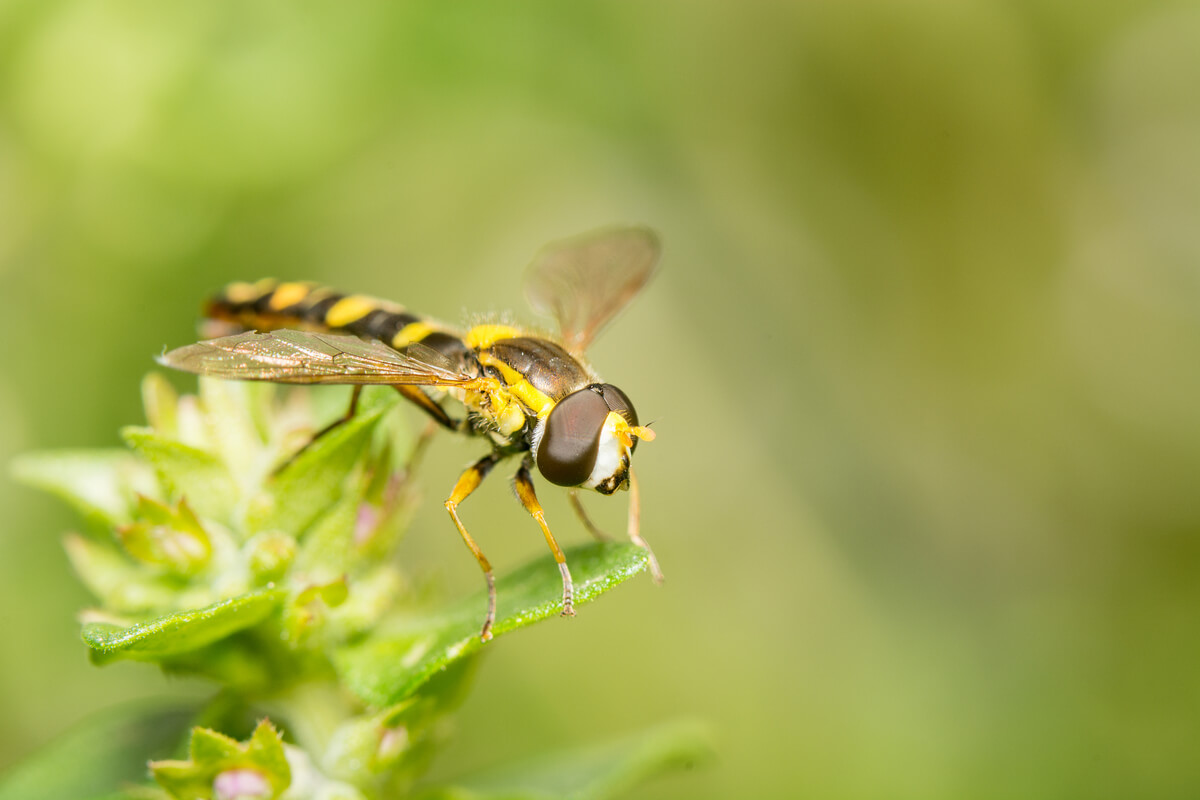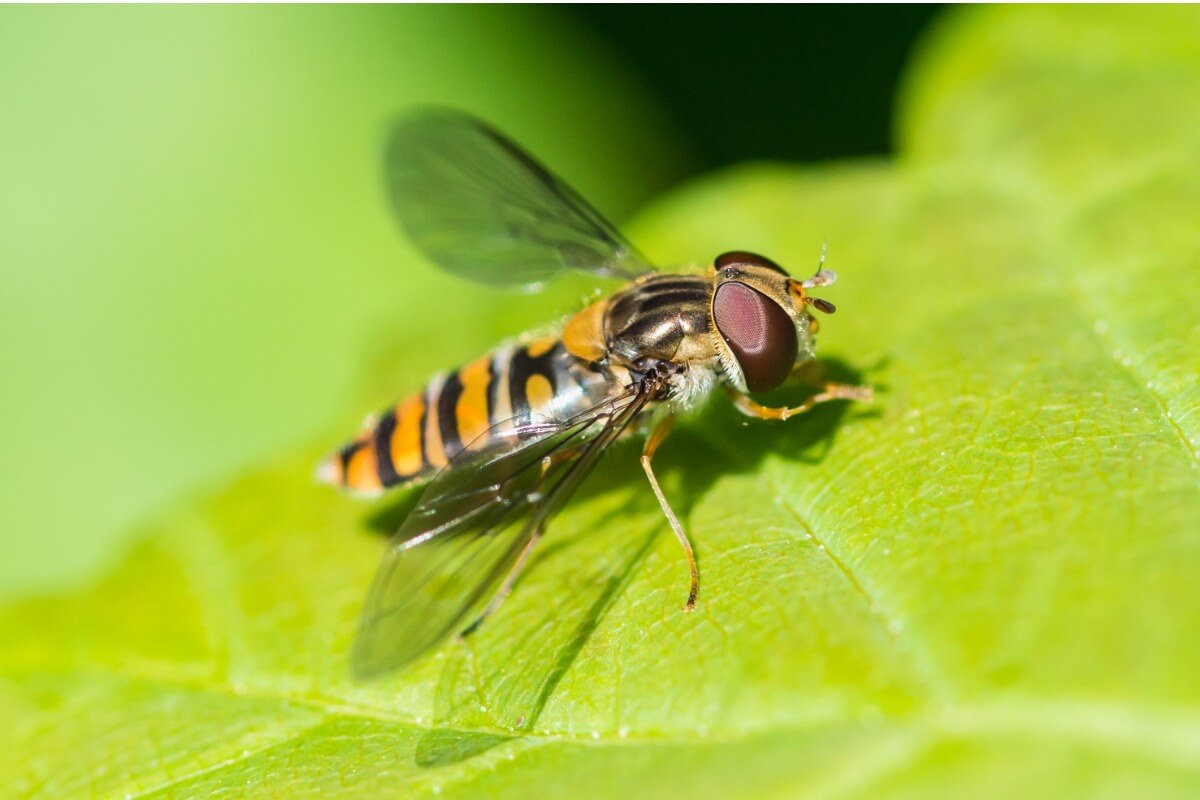What Are Hoverflies?

Insects have a varied range of survival strategies. Among them, we have a particular group that’s similar in physical appearance to bees and wasps, but isn’t poisonous at all. They’re large and colorful flies – let’s learn all about hoverflies.
These insects are very interesting cosmopolitan dipterans, especially because of the important functions they carry out in the ecosystem. Here we present in detail what hoverflies are, what they look like, what they feed on, and some aspects of their life cycle.
What are hoverflies?
As we mentioned at the beginning, hoverflies are insects included in the order Diptera and the family Syrphidae. They’re cosmopolitan, that is, they can be found in various parts of the world (except Antarctica).
There are 284 genera and 6545 described species within their group, and they’re known as hoverflies and flower flies due to their flying ability and feeding habits. They play several roles in the ecosystem: they’re pollinators and play a role as pest controllers in crops.

Hoverflies as pollinators
These insects stand out for their role as pollinators. This role is carried out during their adult stage due to their feeding habits.
Hoverflies are the second most important insects for pollinating some plant species (after Hymenoptera). They have also been reported to be useful in a wide variety of tree and herbaceous crops. One example here is the hoverfly Eristalis tenax, a pollinating agent in outdoor crops.
These diptera tend to be generalists, i.e., they aren’t limited to a specific type of plant. However, certain species do have preferences. Flowers that serve as attractants have characteristics such as light shades (white or yellow), abundant nectar and pollen production, and easy access.
What do hoverflies look like?
Hoverflies undergo changes during their life cycle. Therefore, we’ll describe them in both their adult and immature stages.
Adult hoverflies
Adults come in a variety of shapes, sizes, and colors. Some specimens are very small, while others are larger, ranging from 4 to 25 millimeters in length.
One of the most interesting things about their physical appearance is their similarity in appearance to bees and wasps. In addition, hoverflies have a brown, orange or yellow coloration that’s usually accompanied by accentuated bands on their abdomen. Apart from their colors and shape, some hoverflies even mimic them in behavior.
All this has been developed as a method of defense against enemies. This strategy is known as Batesian mimicry and consists of an imitation of some characteristic of a dangerous organism (poisonous in this case) by a harmless one.
Batesian mimicry makes the hoverflies appear more fearsome and in this way they avoid being preyed upon.
Hoverflies have a body divided into 3 sections: a head with reduced antennae and large eyes (like other flies), a thorax with 6 short legs and wings (one pair functional, the other transformed into outriggers), and an abdomen. Some species have slender bodies and others robust, hairy or hairless bodies.
An exclusive aspect of the family is the presence of a vein in the functional or membranous wings, called the spurious vein.
Immature forms
These dipterans have several wormlike larval stages, without defined legs and heads. Some larvae are found in aquatic environments and others are terrestrial. They may also have a long tail, but it’s nothing more than a siphon that they use to breathe in aqueous spaces.
Eggs are usually whitish in coloration and very small. Pupae are hard due to cuticle transformations in the last larval stage.
What do hoverflies eat?
As is to be expected from their pollinating role, adult hoverflies consume nectar and pollen. They’re constant visitors to flowers, while larvae have very different eating habits. Accordingly, they have 3 different types of feeding:
- Phytophagous larvae: In this case, we have the immature forms that feed on living plant tissues. Some may also feed on fungi (mycophagous).
- Saprophagous larvae: These consume decomposing organic matter. They’re found in a variety of aquatic or humid environments, such as excrement, wood, and slurry, among others.
- Predatory larvae: These feed on other insects, usually soft bodies (aphids, whiteflies, and mealybugs, among others). These stand out for their role as bio-controllers.
Life cycle
Hoverflies go through several stages during their life cycle. The larva emerges from the egg, followed by consecutive larval stages. Then comes the transformation into a pupa, and finally, the adults emerge. The duration of each period and of the total cycle varies in each case based on the particular environmental conditions.
Some species have been studied under controlled laboratory conditions. An example is the predatory hoverfly, Pseudodoros clavatus, which has a total cycle length of 13.6 days (2 as an egg, 6 as larva and 5.6 as a pupa) at 25 °C. This interval depends on the species.

Learning what hoverflies are, as well as their feeding and life cycle, is useful to improve vegetable crops, as they’re important Diptera due to their significant role as pollinators. In addition, some larvae are predators of pests, which increases their usefulness in the agricultural industry.
All cited sources were thoroughly reviewed by our team to ensure their quality, reliability, currency, and validity. The bibliography of this article was considered reliable and of academic or scientific accuracy.
- Arcaya, E., Mengual, X., Pérez-Bañón, C., & Santos, R. (2018). Aspectos biológicos de Pseudodoros clavatus (Fabricius) (Diptera: Syrphidae) alimentado con el áfido de las leguminosas Aphis craccivora Koch (Hemiptera: Aphididae). IDESIA (Chile), 36(2), 269-274.
- Maza, N., Sopena, Y., Assaf, M., Paz, M., & Jaime, A. (2014). Las “moscas de las flores” (Diptera: Syrphidae) en Lules, Tucumán. Revista agronómica del noroeste argentino, 34 (2), 234-235.
- Rader, R., Howlett, B., Cunningham, S., Westcott, D., Newstrom-Lloyd, L., Walker, M., Teulon, D., & Edwards, W. (2009). Alternative pollinator taxa are equally efficient but not as effective as the honeybee in a mass flowering crop. Journal of Applied Ecology, 46(5), 1080-1087.
- Stefanescu, C., Aguado, L., Asís, J.D., Baños-Picón, L., Cerdá, X., García, M., Micó, E., Ricarte, A., & Tormos, J. 2018. Diversidad de insectos polinizadores en la península ibérica. Ecosistemas, 27(2), 9-22.
This text is provided for informational purposes only and does not replace consultation with a professional. If in doubt, consult your specialist.